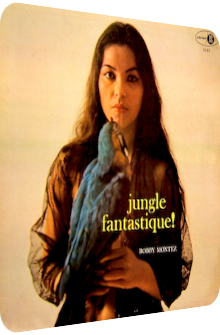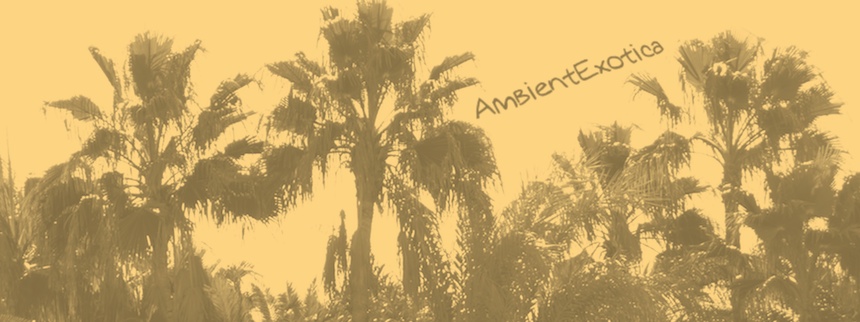
Bobby Montez
Jungle Fantastique!
1958
"Why spend $200-$300 on a hissy original when you can pick up the perfect new copy for a few bucks?" Not only does the management of Cubop Records ask the right questions, they also act accordingly in 2001 and reissue a superb Exotica classic and debut by multi-instrumentalist Bobby Montez (1934–2003). Called Jungle Fantastique!, originally released in 1958 on Jubilee Records and recorded with a quintet, its nine tracks are inspired by the – back then smoking hot – school of Tjaderism, as Cal Tjader’s groundbreaking genre-meshing arrangements can be rightfully called. Driven by the power of the Mambo but branching out to other styles, among them Bolero, Cha Cha Cha and amalgamations thereof, this work is fueled by sunbeams, porously structured to let a gorgeous interplay unfold, and created to enthrall. Jungle Fantastique! features the talent of bandleader
Bobby Montez on the vibraphone, Carlos Ortega Avelar on the piano, an unfortunately less prominently audible Jimmy Baiz on the double bass as well as the talent of two dedicated drummers: conguero Louis Miranda and timbalist Miguel Gutierrez. Given the Latin focus, one should probably expect gallons of Latin clichés such as besotted piano tones, lovestoned shades and eruptive vibraphone curlicues of utter devotion, but nope, this is not the case. While all of these formations are indeed interwoven, the result is awash with light, carefreeness and understanding. High-titer encapsulations of various layers occasionally demand a listener with a greater love for Jazz than Exotica in general, especially so in the rapidly meandering Mambo sessions and because of the increased duration south of the four-minute mark, but there are slower pieces in here alright, ones which foreshadow the acceptance of this new Latin style and splendidly demonstrate that the term Latin is as overarching as other, more problematic genre conventions à la World, Ethnic or even Jazz itself. Don’t let the poor guy’s front artwork with the poor parrot fool you, this album is on par with all those better known classics. And that’s that, now off to the music.
My kingdom for a Mambo, or so the credo seems, as Montez’s quintet plays four and a half songs in this archetypically Latin style. The spiraling African Fantasy opens the roundelay, envisioned by Montez himself. The vibraphone is in the spotlight as expected, its cascading dots glittering in the jungular copse which is augmented by Miguel Gutierrez’s timbales and Louis Miranda’s congos. This frantic, upper midtempo corker does not only enchant with its drums and speed, but features one stellar peculiarity: the synchronization of Oriental tones and glaringly Latin piano scythes as played by Carlos Ortega Avelar. The result is splendid, as the tonalities themselves are common to the Exotica fan’s ears when separated, but very bewildering when being enmeshed. When the song’s last stage then becomes glitzier and loftier at the same time, the synergetic structure has served its purpose: surprising the bystander with a zoetrope of timbres.
Those listeners who are put off by the tempestuous whirlwinds will find the following Chango most applicable. Much more stabilized due to its sun-dried and formidably cinematic prolonged chants, friendly staccato backings, warm piano backdrops and vitreous vibes, Montez is keen on putting euphonious melodies to the foreground, making Chango one of the most accessible and festive pieces that feels like an aural rain forest, a refreshing fluxion of ligneous particles and rays of light.
The following Bolero Jungle Sunset is spectacularly languorous and silky. A downtempo ballad with whitewashed blurs of vibraphone coils, crimson chords on the piano and interstitial reverberations as accompanied by the timbales and congas, Jungle Sunset partially resembles Arthur Lyman’s take on Vera Cruz off Bwana Ā (1959), but is much more colorful even without birdcalls. Side A closes with the frenzied Kon-Tiki, a unique composition of seven minutes, not to be mixed up with The Shadows’ single of the same name that did not appear until 1961. Bobby Montez’s long-winded Mambo extrapolates the interplay between the drummers and consequentially extenuates the helical melodies; the bandleader is still more than willed to be guarded by the partially savage tohubohu, adding another layer to the parallax coppice by playing the vibe like a rhythmic device instead of focusing on melodies that are open to scrutiny. This piece, as the saying goes, has to be experienced. Fans of Cal Tjader and Sabu Martinez will be more than pleased.
Side B kicks off with another Mambo, and once again is it of a striking luminosity: Swinging At The "M" presents greenish vibraphone tones and places them closely to Carlos Ortega Avelar’s piano tones, the latter of which are less Latin than they are sunkissed. The latter half comprises of the diversion of benign sections and livelier ones. Despite the fast-paced physiognomy, Swinging At The "M" allows the decay of the drums to admix a wondrous hollowness to the mix. The following Speak Low is the first rendition of the album. Originally written by Kurt Weill and Ogden Nash, the quintet transforms the classic composition into a magical midtempo Bolero-Cha hybrid that even lives up to any string-heavy rendition. Instead of magenta-tinted violins, Bobby Montez and his men build the bewitching luminescence with the help of an aquatic vibe glissando, a genteel piano undercurrent that leaves room for bassist Jimmy Baiz to soften the fissures. Its evening aura makes Speak Low compatible with the needs of Exotica fans who prefer a meek moiré instead of the friendly turmoil.
This turmoil happens in Montez’s take on Edward Eliscu’s, Gus Kahn’s and Vincent Youmans’ Carioca. The main melody encapsulates slight tinges of pentatonicism and cheeky madness that are not detectable in the gentlemen’s sheet music, but this works to the arrangement’s advantage. The vibraphonist comes quite close to Tjader’s style. Two highlights are a raspy guiro and a piano-vibe intertwinement that foreshadows the sunshiny vistas of the late 60’s; Tjader’s hyper-accessible Solar Heat (1968) comes to mind. While Cha Cha Cha Por Nueva York sees the quintet surfing on rays of light and stroll singingly through a torrid New York that is brought to life via over-the-top chants, crystalline vibe droplets and a piano base frame in adjacency to comparably orderly drum backings, the finale Summertime is a nod to the Gershwin siblings, retaining the piano-centric focus of the original, but replacing the contemplative gaze with the notion of motion, of moving unworried through the loftiest of all seasons. The timbales are lucid and work well together with the whirring vibes, the guiro skeleton and an indefatigable performance by pianist Avelar that subtends the Bolero-Mambo mixture and leads to an uplifting result. The flow is just right, and before one realizes it, the endpoint of Summertime has turned into something entirely else, with the Gershwin classic being almost unrecognizable compared to its opening section.
Jungle Fantastique! is a work of delight. Sentences like these do not develop the aroma they used to, and granted, I am to blame for this, as the alloy of many genres – called Exotica, of course – is simply too vivacious and outstanding for me to not find something positive to say about most works (this even includes Billy Vaughn’s chart-topping Blue Hawaii debacle). Bobby Montez’s work is, as expected, a gorgeous star among the cream of the crop. Notwithstanding the somewhat early proof in 2001 that long-forgotten and lost Exotica records can indeed be properly resurrected and restored, Jungle Fantastique! is a tropical cherubim thanks to its intrinsic qualities. Amiably inspired by Cal Tjader’s works such as Latin Kick (1956), Bobby Montez finds his own concept on this debut already. Reworking classics and putting them into the Exotica corset has been done before and ever since, so it is the unique material that gleams, be it the gentle sunburst and artifact of camaraderie called Chango, the stupefyingly balmy Jungle Sunset with its rubicund gradient or the mercurial-diffractive belter Swinging At The "M", Montez knows a thing or two about a good Mambo. I for one prefer the quintet’s dreamier takes and renditions, but am aware of the the fact that the gentlemen’s true prestidigitation and interdependence is found in the shapeshifting Mambo material.
The secret of Jungle Fantastique! probably lies in the arrangement. This album could have worked splendidly with a quartet. That the album features the talent of timbalist Miguel Gutierrez and conguero Louis Miranda is a testimonial for the drum-oriented layering technique of this composite. Two dedicated drummers are exactly right and do not sound gimmicky at all. Although, come to think of it, the negative connotations of gimmicky have never been an issue in the flamboyant Exotica genre. Jungle Fantastique! does not sport birdcalls or animals, is not as verdured as similarly titled works and may not feature the most beautiful demi-goddess on the front artwork, but remains an important milestone in the genre, one which caters to both Jazz aficionados and their love for labyrinthine structures as well as Easy Listening fans who favor transparency and melodious hooks. Available on vinyl for ridiculous prices, on CD and as a download.
Exotica Review 308: Bobby Montez – Jungle Fantastique! (1958). Originally published on Jan. 25, 2014 at AmbientExotica.com.
